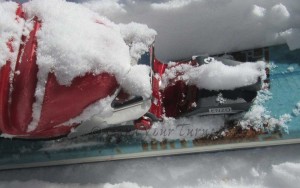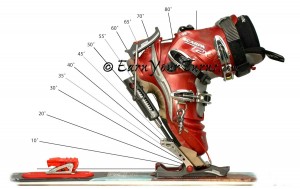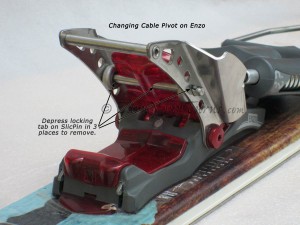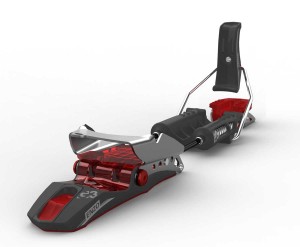It took me awhile to put the pieces together, but right from the get go I knew the tale Oliver Steffen, G3s founder, was spinning about the origins of the Enzo name coming from a box of supplies at an Andean mountain cafe were suspect at best. Even if that tale is true, it makes more sense that Enzo derives from Lorenzo Worster, one of G3’s most seasoned athletes and probably the person who whined the loudest (though he would never admit it) for a new G3 telebinding with all the features of the Enzo.
Aside from my speculation on the origins of the name, there is plenty of tangible evidence that Enzo comes with a lot of admirable traits that puts G3 back in the game with an up-to-date, easy to operate, high performance tele binding.
Except for weight, all the shortcomings of the Ascent, G3s first foray into the world of free-pivot telemark bindings, are overcome with the Enzo. It is powerful, easy to switch modes, and appears to be as immune to icing up as a backcountry binding can be.
Uphill Performance

As hoped, the plastic exo-skin on the Enzo really does keep ice away. The horn under the toe was effective at preventing any ice buildup. The snow in this picture is all loose and easy to shake off.
For the moment I’m willing to accept G3’s claim of fixing the icing issues of the Ascent for a number of reasons. Snow buildup and icing is a problem when touring, specifically when switching back to downhill mode after skinning. All it takes is a little exposed metal in the toe area and snow will glam on and pack in to ice, reducing range of motion and/or preventing a simple mode switch. (Update 07jan13: After 2500 vert of skinning in cold snow the horn under the toe appears to work and the only snow on the binding was loose snow. The absence of any ice, even small amounts, is amazing.)
With the Enzo the only exposed metal on the binding is the toe plate itself, which is open underneath the boot much the same as the Switchback toeplate and thus, by extension, relatively immune to snow buildup underneath. Every other surface is covered with a skin of pliable plastic to shed snow. One of the new features G3 brings to the game is a beautifully sculpted horn in front of the toe, under the duckbill. This creates a wedge to break up snow with each step rather than allow it to pack down on a flat surface.

Enzo delivers a solid 50°+ of frictionless range of motion. With no ice buildup under the toe make that a reliable 50°+.
G3 claims a touring range of motion of 60°. If you measure relative to the heel of your boot, that’s true. I measure range of motion relative to the plane of the toe plate. This stricter standard delivers a solid 50° ROM, which is plenty. Depending on what boot you use, and how soft it is, another 5° or so is easily part of the useful ROM which I indicate with the plus sign. Perhaps more important is how reliable that 50° ROM is. Snow packs under the toe of many 75mm tele bindings, effectively reducing the range of motion. With Enzo’s sculpted horn under the toe, snow buildup will be rare, thus maintaining a full 50°+ in all conditions; more than enough for a clean kick-turn at a tight switchback.
Ascent users will appreciate the improvement to the mode switch which is activated, just like BD’s O1, by pressing a toggle switch at the front of the binding with a ski pole. Except the Enzo switch takes noticeably less pressure to activate than the O1. It is arguably the easiest mode switch to operate of any telemark binding. Like the O1, or Switchback, you can flip it back to turn mode with your heel lifted and the toe plate will lock when you step down. Two tangs that extend from the rear of the toe housing hold down a bar at the back of the toe plate, just like the Voile Switchback.
This method of locking the toe plate down for turning has a solid track record of practically eliminating the tendency to ice up and frustrate switching from earn to turn mode, the Achilles heel of the Ascent.
The Enzo continues the tradition of a spring loaded heel post for easily adding a bit of lift for a steep skin track. The standard post height adds 35mm of lift, or approximately 8° of rise. If that doesn’t suit your preference for competitive skin tracks you can add a climbing wire to raise your heels another 30mm, or another 7° of lift for a total incline of 15°, give or take a degree depending on what size boot you’re in.

To hold the cable so it doesn’t flop around when transporting fit the heel lever in the underside of the heel post. Workable but not clean and lean like G3’s Targa.
As a climbing post, the heel assembly is great. As a way to keep the cable assembly from flopping around when you lash ’em to your skis or shoulder ’em, it’s okay, but not elegant. The tail of the heel lever fits in the molded underside of the heel post when it is lifted. It doesn’t snap into place under tension, but it is held in place. The annoying part is that the heel post only holds the heel lever when it is up, so it doesn’t create a clean, lean profile with the cable held securely in place the way the original Targa does. A small demerit in exchange for vastly improved overall performance.
When combined with resistance to snow packing under the toe there is little to complain about with Enzo’s skinning performance with the exception of weight. Yes, Enzo is one of the heavier telemark touring bindings and there are certainly lighter 75mm options available, but not with the level of power that Enzo can provide.
Downhill Performance
The power train for the Enzo is a pair of compression springs routed underfoot for faster turn engagement. The springs are held in a plastic housing and come in three flavors, soft (black), medium (silver), and stiff (gold). The cable pivot point is adjustable so you can set the tele-resistance to the level you want. The standard springs come with a medium spring rate that delivers up to HH#4 tension at the rear-most pivot point. If you want even higher tension, get the stiff springs. Be aware changing the cable pivot position causes the cable to change in length relative to the heel of your boot, so you will need to tighten or loosen the cable after adjusting the pin position. If you like moderate tension, go for position #2, high tension, use #3 and then you’ll only need to do this once.

To switch the cable pivot position lift the toeplate in tour mode so you can depress the locking tab of the SlicPin in 3 places. Not difficult, nor idiot proof.
This brings up one of the few shortcomings of the Enzo. To adjust the cable pivot point, and thus the relative turning power, you move a Slic™ Pin similar to that used by Axl. However, the procedure is slightly more complicated than with the Axl. You need to switch the toe plate to touring mode, and then pivot the toeplate up. Then depress the locking button on the Slic™ Pin and pull it out. The locking tab on the slick pin needs to be depressed three times to change the position – once to pull it past the sidewall of the toeplate and first cable yoke, a second time to get past the center rib of the pivoting toe plate shim, and finally again to get past the second cable yoke and sidewall of the toe plate. It’s not difficult, just less convenient than Axl but a whole lot easier than changing cartridges on the O1. Besides, how often do you think you’ll change the cable pivot position? I’ll wager thrice. Once to increase power, a second time to move it back for comparison, and the final time back in the power position. That’s the last time you’ll need to push the SlicPin latch to move it. IOW – no big deal!
Back to the power you can expect with Enzo. It has a 3° ramp angle on the toe plate which helps defuse rocker in older boots and allows for faster turn engagement. While the actual cable tension of Enzo may equal that of Axl, when skiing it feels slightly less, perhaps due to shorter sidewalls on the toe plate which yields a hair less lateral control than Axl #2, but solidly more than O1, even with rid-stiff springs. What does this mean in practical terms? Enzo’s can drive any width ski you’re comfortable riding on – low-fat, mid-fat, full-fat, or super-fat.
Logistics
One of the overlooked features of tele bindings is how easy they are, or are not, to get in to. AT skiers like to ridicule the necessity of bending over to latch the cable around the heel of our boots, but with the Enzo I can be securely latched-in far faster than Dynafiddlers, and equally as fast as friends using Dukes, Freerides, or NTN. The heel lever on the Enzo lines up perfectly with the groove on the heel making it one of the fastest heel levers in the backcountry. If you have trouble bending over, perhaps you need to spend more time on the skin track and less at Lenny’s pancake house. 😉
As with its predecessor, the Ascent, Enzo uses six mounting screws. The overall area encompassed is the same as the 4-hole Targa pattern, but with two additional screws roughly in the middle. Unlike the Ascent, these extra screws can be driven in straight, although you need to have the cables disconnected to do so. This isn’t much of an issue during installation, just a picky detail when transferring to a new pair of skis.
As of this writing there are no ski crampons available to work with Enzo, but that will probably change in time.
Conclusion
While the Enzo combines a number of the best telemark binding ingredients available on the market the combined weight of Enzo’s features comes at a hefty cost of nearly four pounds per pair. That is probably the most unappealing factor of the Enzo. Thankfully it is not the heaviest free-pivoting binding on the market and the fact that the touring mode is a true frictionless pivot, theoretically immune to snow and ice buildup makes it a binding still worth serious consideration.
If you still haven’t upgraded to a free-pivot binding from your old Targa’s because you had so many fine memories associated with the G3 name you need not jump ship anymore. You can still earn your turns with a G3 binder, only now with a powerful underfoot routed cable system that can switch to a free-pivot touring mode without fear of icing up. You know you want one ‘cuz resistance is futile.
Genuine Guide Gear
Enzo
MSRP: $290
Weight/pair: 3 lbs., 14 oz. (1.76 kg)
Springs available: Soft (black), Medium (silver – std), Stiff (gold).
© 2012


22 comments
5 pings
Skip to comment form
seems rather Axl-like, but with perhaps better icing prevention?
Axl power-train, O1 clutch, Switchback seat, old-school price.
How’s the performance with NTN boots? That’s all that matters anymore. Duckbills are as outdated as leather and pine tar.
Not so fast there Clyde – and certainly not based on sales of NTN products. Whether NTN will pull tele out of the doldrums and increase interest in telemark remains to be seen. If folks become interested in tele, I doubt it is because of new technology – rather it is a fascination with how stubbornly some of us refuse to give up doing a curtsey when we turn. They’re right to believe there’s more to it than just skiing.
Beats me why more makers don’t copy the beaver tail on the HH heel throw or is that patented? Makes it dead easy to lock the cable around the heel.
Agree with you that once folks have dialed their pivot point they’re unlikely to change it often.
I’m impressed with 22 Designs engineering innovation and build quality,
(even their leashes) but that quality comes at the cost of weight in the case of the Axls. 1kg each near enough, 2kg per touring boot near enough … just as well I have thighs of steel 😉
But anyway it’s good to see competition yielding greater choice at this end of the binding market.
What a great pithy summary. Bravo!
Ern,
Pride and or patents are the main reasons more makers don’t copy good features from competitors. Don’t know if the beaver-tail is patented by 22D. I don’t think so. G3 created a modified version of that with their Targa touring heel throw. They improved upon it for the Enzo and I must admit it works even better (the heel lever that is) than the 22D beaver-tail.
I’ve been thinking of dropping some $$$ on the G3 Enzo’s, but I’m a little concerned with all the plastic that I see in pics. Any opinions on the duribility of these critters?
Lots of plastic in lots of bindings these days. By and large it is all pretty durable with the odd exception here and there due to batch problems with materials composition. Most of the plastic on the Enzo is beefy enough, and in places where it has been used for years without trouble, like the heel throw, climbing post, and the anti-ice plate under the toe. The plastic skin that snaps into place under the foot or in front of the toe does seem a bit thin, and could conceivably crack, but it would be easy to replace too.
LOL. Love your post Dostie.
Field repairs, and the kit needed to do it, would make for a very useful post Dostie. I don’t mean binding specific stuff – that’s obviously relevant where there are known vulnerabilities and that’s perhaps too broad a brief (but perhaps not with your knowledge) but general stuff about how to get yourself out of the merde with fencing wire, duct tape, epoxy or prayer.
I’ve been thinking about buying this binding, but I’m not sure which springs to go for. I’ve previously skied the stiffest version of the BD O1 and I really liked that stiffness, which Enzo model compares to that…?
Andreas,
Probably the standard or stiffer spring. Unlike the O1, you adjust the power of the binding largely by moving the pivot location. With the O1 all you can do is adjust tension by changing the spring rate. Of the two – moving the cable pivot is WAY more effective at improving the tele-resistance you feel in a turn.
Thanks for the reply! I think I’ll go for the standard springs…
Dostie, What’s the red plate under the heel block (looks like some sweet system for sliding the heel block) in the photo that shows how the heel throw fits under the climbing block?
The red plate under the heel post is a rental shim to allow quick adjustments on the position of the heel. Not standard equipment, but part of the rig I used for testing.
I have had numerous times (often skiing bumps) when the climbing post pops up which requires stopping to put it down. I have taken to wiring it down. Has anyone else had this problem
I had this problem on day one with my first Enzo. (I now have two.) It was caused by mounting the heel piece too far back for my boot. Every time my heel went down hard the heel piece came up. The quick fix was too loosen the two screws holding down the heel piece and slide it forward.
Later I had a problem related to incorrect placement of the heel piece. In certain climbing situations the heel lifter would partially collapse when weight was placed on it. It was hard to figure this out in the field. My second Enzo didn’t have the problem. But it was mounted by the same shop, although they had learned from their error on the first mount. I asked that new heel holes be drilled for the original mount just like the second mount. That cured this problem too.
It seems to me that G3 needs to train dealers better about this binding.
I’d like to offer a comment regarding the Enzo’s standard spring.
The review states “The standard springs come with a medium spring rate that delivers up to HH#4 tension at the rear-most pivot point.” That’s not my experience. The rear-most position is the most active. I found that the front-most position is MORE active that HH#5 with the standard spring. The binding was usable with this spring, but it was so different from all my other bindings that changing over required a big adjustment by me. (With the HH, I found #3 to be a setting that was more reasonable. It provides nice activity without distorting my skiing to be HH biased.)
I changed my Enzos over to the softer, black, spring. This was much better, in my opinion. In position one, most forward, the binding seemed totally neutral. (Of course, if you want a neutral binding, why pay the added expense of an Enzo!) I found that the middle, second, position corresponded to what I feel the HH#3 to be and this is what I use. I haven’t bothered to try the most active position. (Changing activity position is such a job I’m not inclined to experiment if not really necessary!) To help you evaluate my opinion, I offer this. I weigh 155 to 160lbs and ski with Scapa T2 Eco boots. I use the Enzo on 177cm Volkl Kendos and 178cm Nunataqs.
I forgot to mention that currently you don’t seem to be able to buy the Enzo with the black spring. That’s an extra cost. This is rather annoying. What am I supposed to do with eight silver Enzo springs–I have two pair of Enzos–I have no use for?
I spoke with the G3 rep at the tele festival at mad River and he said there was an issue on a batch of climbing posts that caused the behavior we are seeing. He took my name and was supposed to send me new ones but in the meantime he wired them down, which was a very effective solution. I am still waiting for the new ones but I will go to the ski shop next fall and have them get them for me.
Compared to Axl, Enzo takes much longer to set up while mounting, and changing the activity pin is trying and tedious at best (requires Pozi drive screwdriver). Anti-icing looks smart, and overall binding looks like good competitor for Axl and 01.
[…] you love your current 75mm boots stick with 75mm options like O1, Axl, Enzo, RT Spike, Switchback or the X2 version, and if you must have a safety release, 7tm Power […]
[…] 3lbs. 13 oz./pair (1734 g/pr) • $289The one nobody caught wind of until after Christmas was Enzo, G3′s return to the tele market. On first look Enzo appears to be a synthesis of numerous […]
[…] so are the Switchback brothers, and BD’s O1. All decent choices and now joined by G3′s Enzo which lived up to my expectations of shedding snow and not icing up. NTN is taking root now that […]
[…] to sell off the number of bindings built for a minimum production run. There remains hope for Enzo’s future since the Enzo R, a non-touring version of the Enzo with fewer parts, will continue to be […]
[…] G3 Enzo […]